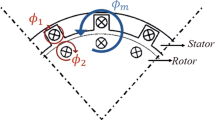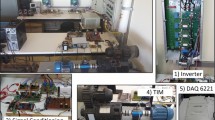Abstract
Characteristics like robustness, adaptability to several load conditions, and low costs of operation and maintenance are some of the reasons three-phase induction motors are ubiquitous in industrial applications. Even so, these machines are subjected to electrical and mechanical faults which can result in malfunction. The detection of incipient faults is the focus of several recent studies because they provide information for timely decisions to avoid unplanned stops of industrial processes. A common problem of induction motors is the presence of broken rotor bars. Most of the methods of condition monitoring and fault diagnosis focus on the usage of only one type of power supply: line-connected or fed by frequency inverters. Given this situation, we present an alternative technique for the detection of broken rotor bars of three-phase induction motors regardless of the type of power supply. Our approach is based on similarity measures of the stator current signals of two motor phases in order to extract the relevant features of such signals, which are then classified using three intelligent systems: artificial neural network, support vector machines, and k-nearest neighbors. We performed 3310 experimental tests with motors operating in steady state, with sinusoidal and non-sinusoidal power supply, and variations of voltage unbalance levels, supply frequency, and load torque. Classification accuracy rates over 92% of success were obtained in these tests, which validate the proposed approach.









Similar content being viewed by others
References
Abd-el-Malek M, Abdelsalam AK, Hassan OE (2017) Induction motor broken rotor bar fault location detection through envelope analysis of start-up current using Hilbert transform. Mech Syst Signal Process 93:332–350
Alonso J, Mananas M, Hoyer D, Topor Z, Bruce E (2007) Evaluation of respiratory muscles activity by means of cross mutual information function at different levels of ventilatory effort. IEEE Trans Biomed Eng 54(9):1573–1582
Appana DK, Prosvirin A, Kim JM (2018) Reliable fault diagnosis of bearings with varying rotational speeds using envelope spectrum and convolution neural networks. Soft Comput 22(20):6719–6729
Bandyopadhyay S, Saha S (2013) Unsupervised classification: similarity measures, classical and metaheuristic approaches, and applications. Springer, New York
Bessam B, Menacer A, Boumehraz M, Cherif H (2016) Detection of broken rotor bar faults in induction motor at low load using neural network. ISA Trans 64:241–246
Bishop CM (2006) Pattern recognition and machine learning. Springer, New York
Boudinar AH, Benouzza N, Bendiabdellah A, Khodja MEA (2016) Induction motor bearing fault analysis using a root-MUSIC method. IEEE Trans Ind Appl 52(5):3851–3860
Chen CLP, Liu Z (2018) Broad learning system: an effective and efficient incremental learning system without the need for deep architecture. IEEE Trans Neural Netw Learn Syst 29(1):10–24
Cover T, Thomas J (2006) Elements of information theory, 2nd edn. Wiley-Interscience, New York
Delgado-Arredondo PA, Morinigo-Sotelo D, Osornio-Rios RA, Avina-Cervantes JG, Rostro-Gonzalez H, de Jesus R-TR (2017) Methodology for fault detection in induction motors via sound and vibration signals. Mech Syst Signal Process 83:568–589
Deng W, Yao R, Zhao H, Yang X, Li G (2019) A novel intelligent diagnosis method using optimal LS-SVM with improved PSO algorithm. Soft Comput 23(7):2445–2462
Dias CG, Pereira FH (2018) Broken rotor bars detection in induction motors running at very low slip using a Hall effect sensor. IEEE Sens J 18(11):4602–4613
Drif M, Kim H, Kim J, Lee SB, Cardoso AJM (2017) Active and reactive power spectra-based detection and separation of rotor faults and low-frequency load torque oscillations. IEEE Trans Ind Appl 53(3):2702–2710
Faiz J, Ebrahimi B, Akin B, Toliyat H (2010) Dynamic analysis of mixed eccentricity signatures at various operating points and security of related indices for induction motors. IET Electr Power Appl 4(1):1–16
Frosini L, Harlişca C, Szabó L (2015) Induction machine bearing fault detection by means of statistical processing of the stray flux measurement. IEEE Trans Ind Electron 62(3):1846–1854
Garcia-Calva TA, Morinigo-Sotelo D, de Jesus R-TR (2017) Non-uniform time resampling for diagnosing broken rotor bars in inverter-fed induction motors. IEEE Trans Ind Electron 64(3):2306–2315
García-scudero LA, Duque-Perez O, Fernandez-Temprano M, Morinigo-Sotelo D (2017) Robust detection of incipient faults in VSI-fed induction motors using quality control charts. IEEE Trans Ind Appl 53(3):3076–3085
Gyftakis KN, Antonino-Daviu JA, Garcia-Hernandez R, McCulloch MD, Howey DA, Cardoso AJM (2016) Comparative experimental investigation of broken bar fault detectability in induction motors. IEEE Trans Ind Appl 52(2):1452–1459
Hall M, Frank E, Holmes G, Pfahringer B, Reutemann P, Witten IH (2009) The WEKA data mining software: an update. ACM SIGKDD Explor Newsl 11(1):10–18
Hou Z, Huang J, Liu H, Wang T, Zhao L (2016) Quantitative broken rotor bar fault detection for closed-loop controlled induction motors. IET Electr Power Appl 10(5):403–410
Jerkan DG, Reljić DD, Marčetić DP (2017) Broken rotor bar fault detection of IM based on the counter-current braking method. IEEE Trans Energy Convers 32(4):1356–1366
Kim YH, Youn YW, Hwang DH, Sun JH, Kang DS (2013) High-resolution parameter estimation method to identify broken rotor bar faults in induction motors. IEEE Trans Ind Electron 60(9):4103–4117
Konar P, Chattopadhyay P (2015) Multi-class fault diagnosis of induction motor using Hilbert and wavelet transform. Appl Soft Comput 30:341–352
Konar P, Sil J, Chattopadhyay P (2015) Knowledge extraction using data mining for multi-class fault diagnosis of induction motor. Neurocomputing 166:14–25
Liboni LH, Flauzino RA, da Silva IN, Marques Costa EC (2019) Efficient feature extraction technique for diagnosing broken bars in three-phase induction machines. Measurement 134:825–834
Liu W, Pokharel PP, Principe JC (2007) Correntropy: properties and applications in non-gaussian signal processing. IEEE Trans Signal Process 55(11):5286–5298
Liu R, Yang B, Zio E, Chen X (2018) Artificial intelligence for fault diagnosis of rotating machinery: a review. Mech Syst Signal Process 108:33–47
Li B, Zhang PL, Tian H, Mi SS, Liu DS, Ren GQ (2011) A new feature extraction and selection scheme for hybrid fault diagnosis of gearbox. Expert Syst Appl 38(8):10000–10009
Martin-Diaz I, Morinigo-Sotelo D, Duque-Perez O, Arredondo-Delgado P, Camarena-Martinez D, Romero-Troncoso R (2017) Analysis of various inverters feeding induction motors with incipient rotor fault using high-resolution spectral analysis. Electr Power Syst Res 152(Supplement C):18–26
Martinez J, Belahcen A, Muetze A (2017) Analysis of the vibration magnitude of an induction motor with different numbers of broken bars. IEEE Trans Ind Appl 53(3):2711–2720
Melia U, Guaita M, Vallverdú M, Embid IC, Vilaseca SM, Santamaria J (2015) Mutual information measures applied to EEG signals for sleepiness characterization. Med Eng Phys 37(3):297–308
Morales-Perez C, Rangel-Magdaleno J, Peregrina-Barreto H, Amezquita-Sanchez JP, Valtierra-Rodriguez M (2018) Incipient broken rotor bar detection in induction motors using vibration signals and the orthogonal matching pursuit algorithm. IEEE Trans Instrum Meas 67(9):2058–2068
Moussa MA, Boucherma M, Khezzar A (2017) A detection method for induction motor bar fault using sidelobes leakage phenomenon of the sliding discrete fourier transform. IEEE Trans Power Electron 32(7):5560–5572
Naha A, Samanta AK, Routray A, Deb AK (2016) A method for detecting half-broken rotor bar in lightly loaded induction motors using current. IEEE Trans Instrum Meas 65(7):1614–1625
Nichols J (2006) Examining structural dynamics using information flow. Probab Eng Mech 21(4):420–433
Panagiotou PA, Arvanitakis I, Lophitis N, Antonino-Daviu JA, Gyftakis KN (2019) A new approach for broken rotor bar detection in induction motors using frequency extraction in stray flux signals. IEEE Trans Ind Appl 55(4):3501–3511
Principe JC (2010) Information theoretic learning—Renyi’s entropy and kernel perspectives. Springer, New York
Romero-Troncoso RJ, Saucedo-Gallaga R, Cabal-Yepez E, Garcia-Perez A, Osornio-Rios RA, Alvarez-Salas R, Miranda-Vidales H, Huber N (2011) FPGA-based online detection of multiple combined faults in induction motors through information entropy and fuzzy inference. IEEE Trans Ind Electron 58(11):5263–5270
Romero-Troncoso R, Garcia-Perez A, Morinigo-Sotelo D, Duque-Perez O, Osornio-Rios R, Ibarra-Manzano M (2016) Rotor unbalance and broken rotor bar detection in inverter-fed induction motors at start-up and steady-state regimes by high-resolution spectral analysis. Electr Power Syst Res 133:142–148
Samanta AK, Naha A, Routray A, Deb AK (2018) Fast and accurate spectral estimation for online detection of partial broken bar in induction motors. Mech Syst Signal Process 98:63–77
Schölkopf B, Burges CJC, Smola AJ (1998) Advances in kernel methods: support vector learning. MIT Press, Boston
Seshadrinath J, Singh B, Panigrahi B (2014) Investigation of vibration signatures for multiple fault diagnosis in variable frequency drives using complex wavelets. IEEE Trans Power Electron 29(2):936–945
Siljak H, Subasi A, Upadhyaya BR (2018) Hardware implementation of auto-mutual information function for condition monitoring. Comput Electr Eng 66:30–39
Silva IN, Spatti DH, Flauzino RA, Liboni LHB, Alves SFR (2017) Artificial neural networks: a practical course, 2nd edn. Springer, New York
Singh S, Kumar N (2017) Detection of bearing faults in mechanical systems using stator current monitoring. IEEE Trans Ind Inf 13(3):1341–1349
Sousa KM, da Costa IBV, Maciel ES, Rocha JE, Martelli C, da Silva JCC (2017) Broken bar fault detection in induction motor by using optical fiber strain sensors. IEEE Sens J 17(12):3669–3676
Togban E, Ziou D (2018) Classification using hierarchical mixture of discriminative learners: How to achieve high scores with few resources? Expert Syst Appl 96:14–24
Trachi Y, Elbouchikhi E, Choqueuse V, Benbouzid MEH (2016) Induction machines fault detection based on subspace spectral estimation. IEEE Trans Ind Electron 63(9):5641–5651
Trachi Y, Elbouchikhi E, Choqueuse V, Benbouzid MEH, Wang T (2017) A novel induction machine fault detector based on hypothesis testing. IEEE Trans Ind Appl 53(3):3039–3048
Trujillo-Guajardo LA, Rodriguez-Maldonado J, Moonem MA, Platas-Garza MA (2018) A multiresolution Taylor–Kalman approach for broken rotor bar detection in cage induction motors. IEEE Trans Instrum Meas 67(6):1317–1328
Vapnik V (2000) The nature of statistical learning theory, 2nd edn. Springer, New York
Xu B, Sun L, Xu L, Xu G (2012) An ESPRIT-SAA-based detection method for broken rotor bar fault in induction motors. IEEE Trans Energy Convers 27(3):654–660
Yagami Y, Araki C, Mizuno Y, Nakamura H (2015) Turn-to-turn insulation failure diagnosis of stator winding of low voltage induction motor with the aid of support vector machine. IEEE Trans Dielectr Electr Insul 22(6):3099–3106
Zhang W, Li C, Peng G, Chen Y, Zhang Z (2018) A deep convolutional neural network with new training methods for bearing fault diagnosis under noisy environment and different working load. Mech Syst Signal Process 100:439–453
Zhang S, Zhang S, Wang B, Habetler TG (2020) Deep learning algorithms for bearing fault diagnostics—a comprehensive review. IEEE Access 8:29,857–29,881
Zhao W, Wang L (2019) Multiple-kernel MRVM with LBFO algorithm for fault diagnosis of broken rotor bar in induction motor. IEEE Access 7:182,173–182,184
Zhao H, Zheng J, Xu J, Deng W (2019) Fault diagnosis method based on principal component analysis and broad learning system. IEEE Access 7:99,263–99,272
Zhao R, Yan R, Chen Z, Mao K, Wang P, Gao RX (2019) Deep learning and its applications to machine health monitoring. Mech Syst Signal Process 115:213–237
Zheng L, Li Y, Chen W, Wang Q, Jiang Q, Liu G (2018) Detection of respiration movement asymmetry between the left and right lungs using mutualinformation and transfer entropy. IEEE Access 6:605–613
Acknowledgements
This work was supported in part by the National Council for Scientific and Technological Development (CNPq), Grants 474290/2008-5, 473576/2011-2, 552269/2011-5, and 307220/2016-8; in part by the Araucária Foundation of Support to the Scientific and Technological Development of Paraná (Grant 06/56093-3), in part by the Coordenação de Aperfeiçoamento de Pessoal de Nível Superior—Brasil (CAPES)—Finance Code 001, and by the Federal University of Technology—Paraná.
Author information
Authors and Affiliations
Corresponding author
Ethics declarations
Conflict of interest
The authors declare they have no conflict of interest.
Ethical approval
This article does not contain any studies with human participants or animals performed by any of the authors.
Additional information
Communicated by V. Loia.
Publisher's Note
Springer Nature remains neutral with regard to jurisdictional claims in published maps and institutional affiliations.
Rights and permissions
About this article
Cite this article
Bazan, G.H., Goedtel, A., Scalassara, P.R. et al. Rotor fault diagnosis of frequency inverter fed or line-connected induction motors using mutual information. Soft Comput 25, 1309–1324 (2021). https://doi.org/10.1007/s00500-020-05224-9
Published:
Issue Date:
DOI: https://doi.org/10.1007/s00500-020-05224-9




